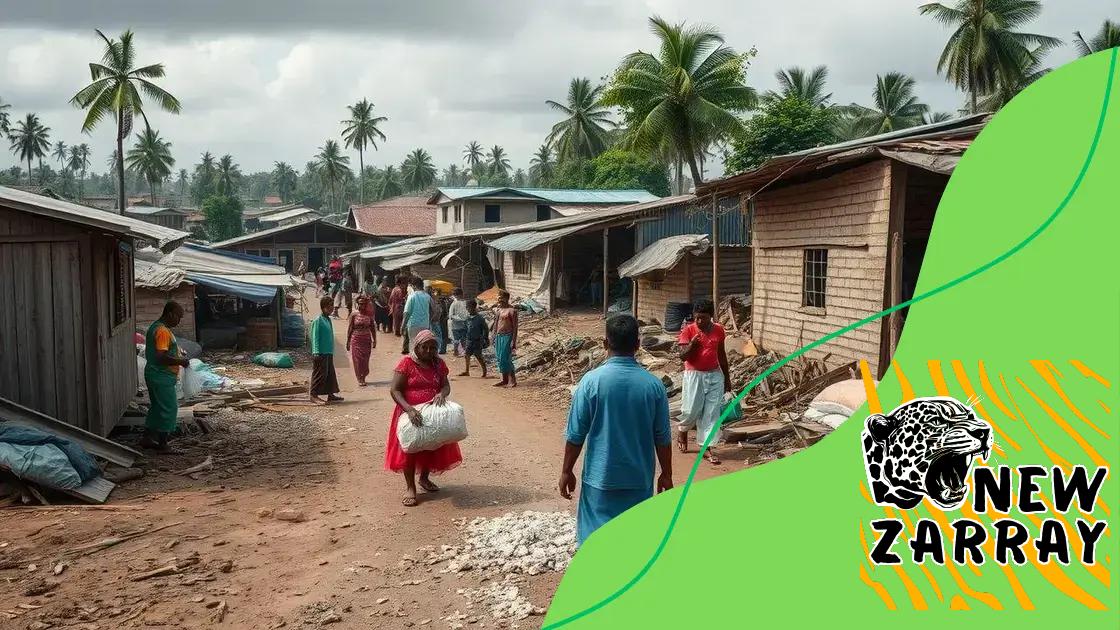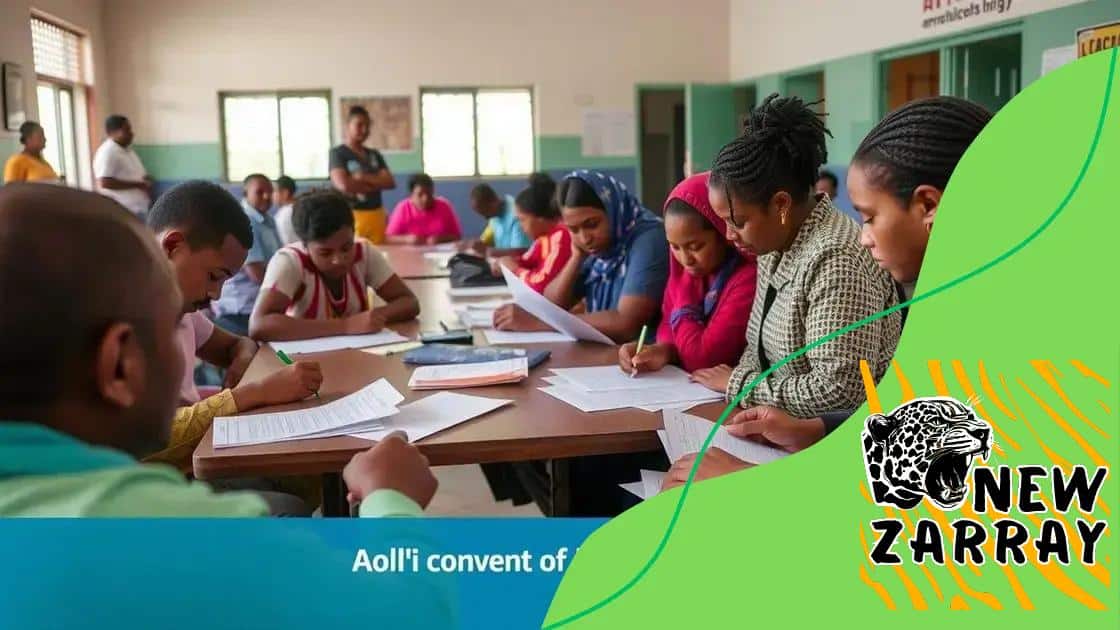Financial aid for disaster-stricken areas: how to access it

Financial aid for disaster-stricken areas provides essential resources to help individuals and communities recover, fostering economic growth, community empowerment, and long-term resilience against future disasters.
Financial aid for disaster-stricken areas is essential for communities recovering from crises. Have you ever wondered how to navigate the maze of assistance available? This article will guide you through the options.
Understanding financial aid mechanisms
Understanding the different financial aid mechanisms available is essential for those affected by disasters. There are various forms of aid, each with its own purpose and eligibility criteria. Whether you are an individual or part of a whole community, knowing what resources are available can make a real difference.
Types of Financial Aid
Many funds and programs help disaster-stricken areas. These can come from governmental bodies, non-profit organizations, or even private donations. Here are the main types of aid:
- Federal Grants and Loans: The government often provides funds to support recovery and rebuilding efforts.
- Community Support Programs: Local organizations may offer assistance tailored to specific community needs.
- Insurance Claims: Collecting on existing policies can provide crucial resources for recovery.
- Nonprofit Organizations: These groups frequently step in with both financial assistance and supplies to assist communities.
In addition to traditional forms of assistance, there are often less formal avenues that can provide help. Online crowdfunding, for instance, has become a popular way for communities to gather resources quickly. These platforms allow individuals to share their stories and receive support from people around the country or even the world.
Another aspect worth noting is the application process for these aids. Many might feel overwhelmed, but steps can be simplified. Documentation is typically required, so gathering important papers ahead of time can speed things up. Moreover, local agencies often offer guidance on how to apply for aid effectively.
Accessing Help
Whether you are looking for personal aid or seeking to support your community, understanding how to access help is crucial. Many organizations hold informational sessions to educate people about their options. Attending these can provide insight into the best steps to take.
It’s also vital to keep track of deadlines because financial aid programs may have limited windows of availability. Knowing when these opportunities arise can ensure you or your community secures much-needed resources as quickly as possible.
Types of assistance available
When it comes to types of assistance available for disaster-stricken areas, there is a wide range of options that can help individuals and communities recover. Understanding these resources is pivotal, especially when time is of the essence.
Federal Assistance Programs
The federal government plays a significant role in providing financial aid. Programs such as FEMA (Federal Emergency Management Agency) offer grants and loans to support recovery efforts.
- Individual Assistance Programs: These provide financial help for basic needs like housing and personal property.
- Public Assistance Programs: Funds are available for repairing infrastructure and restoring public services.
- Hazard Mitigation Assistance: This funding helps communities reduce future risks of disasters.
- Disaster Unemployment Assistance: This program aids individuals who lost their jobs due to disasters.
In addition to federal programs, local governments and non-profits often step in to provide support. Community-driven initiatives can also offer immediate help.
Local and Nonprofit Initiatives
Local governments frequently create programs tailored to the unique needs of their communities. These initiatives may include providing shelter, food, and immediate medical assistance. Nonprofit organizations are crucial in this landscape, mobilizing quickly to assist those in need.
Volunteers play a big role here, helping distribute supplies and offering emotional support. In times of crisis, community connections strengthen, and often lead to creative solutions for challenges faced.
Many charities also run campaigns to collect donations specifically for relief efforts. These funds are then used to purchase necessities, ensuring that help gets to those impacted swiftly. The combination of grassroots efforts with larger institutional support often leads to a more effective response.
Challenges in Accessing Assistance
Despite the numerous options available, many people face challenges in accessing assistance. Lack of information can hinder those in need, preventing them from finding the support they are eligible for. Additionally, some may struggle with the application process, which can be confusing and lengthy.
Engaging community leaders and local organizations can bridge these gaps. They can inform individuals about available resources and provide guidance through the application process, easing frustration and uncertainty.
Application processes for disaster relief

The application processes for disaster relief can seem complicated, but understanding the steps involved makes it easier. Getting the help you need starts with knowing what to expect.
Documentation Required
When applying for disaster relief, certain documents are typically required. Having these ready can speed up your application process significantly. Here are some essential items to prepare:
- Proof of Identity: This can include a driver’s license, passport, or other official ID.
- Proof of Residency: Statements or records showing where you lived before the disaster.
- Damage Documentation: Photos or reports detailing the damage suffered.
- Insurance Information: Any relevant policies and claim details.
These documents help establish your claim and show your eligibility for various assistance programs. A clear and organized submission can improve your chances of a smoother process.
Steps to Apply
Once you have gathered the necessary documentation, the next step is submitting your application. Depending on the program, applications may be submitted online, by phone, or in person.
For many federal programs, applications can be easily accessed online. After filling out your application, make sure to double-check it for errors before submission. Small mistakes can lead to delays.
In case you prefer personal assistance, visiting local disaster recovery centers can be helpful. Staff at these centers can guide you through the application process, ensuring you do not miss any critical steps.
Common Challenges
Many people encounter challenges during the application process. Sometimes, they might not have all the right documents or may struggle with complicated forms. To overcome these hurdles, staying organized and seeking help when needed is vital.
Joining community groups or forums can also offer valuable support. Many who have gone through the process can share tips and advice, helping newcomers navigate the system more effectively.
Success stories of aid recipients
Success stories of aid recipients show the real impact of financial assistance in disaster-stricken areas. These narratives highlight resilience and the critical role of community support in overcoming challenges.
Community Recovery and Rebuilding
In many cases, individuals and families have transformed their lives with the help of financial aid. For example, a family affected by flooding received funds from a local charity, allowing them to rebuild their home and return to normalcy.
Many community members rallied to support this family during their recovery. This spirit of cooperation reflects the strength that arises in times of crisis.
Innovative Use of Assistance
Some recipients have used their aid creatively. One small business owner, for example, received disaster relief funds that allowed her to not only repair her shop but also expand her services. With the help she received, her business grew, creating jobs in the community.
This innovative approach illustrates how aid can be a stepping stone for broader change, encouraging individuals to invest in their futures.
Emotional and Psychological Support
The financial assistance provided often extends beyond material needs. Many recipients talk about the emotional and psychological relief that comes from knowing help is available. This support can help rebuild hope in communities devastated by disaster.
These stories show that every experience is unique. The support provided through grants or loans often comes with counseling services, giving recipients a well-rounded approach to recovery.
Sharing Experiences to Inspire Others
Finally, many aid recipients have chosen to share their stories to inspire others facing similar struggles. They often participate in local events and workshops to discuss their journey, helping others understand how to navigate the application process and access available resources.
These shared experiences provide hope and encouragement, indicating that recovery is possible with the right support.
Long-term benefits of financial support
The long-term benefits of financial support for disaster-stricken areas are profound and wide-reaching. This assistance is not just about immediate relief; it can lead to sustainable recovery and growth for communities.
Economic Recovery
Financial aid helps jumpstart economic recovery. When individuals receive funds, they can spend on necessities such as food, clothing, and housing. This spending stimulates the local economy, helping stores and businesses rebuild and thrive.
- Job Creation: As businesses recover, they may start hiring more workers. This generates jobs, which further boosts the local economy.
- Investment in Infrastructure: Funds can be used for critical infrastructure repairs, improving roads, bridges, and public facilities.
- Support for Local Services: Schools and healthcare services can receive funding aimed at restoring essential services disrupted by disasters.
When financial aid is utilized effectively, it enhances not only individual lives but also the community as a whole. This approach paves the way for a stronger economic foundation.
Social Development
Long-term financial support can also lead to significant social development. Communities that receive assistance can invest in programs that promote education and mental health services.
These programs provide individuals with the tools to overcome their trauma and build resilience. From counseling to job training, this support can help people regain confidence and find new opportunities post-disaster.
Community Empowerment
Another vital long-term benefit is community empowerment. Financial assistance enables neighborhoods to band together, fostering a stronger sense of unity and collaboration. With resources, communities can organize to address their unique needs and concerns.
This sense of ownership can lead to long-lasting change, as residents become active participants in rebuilding rather than passive recipients of aid. Empowered communities often advocate for their interests, leading to better local governance and resource allocation.
Lessons Learned for the Future
Moreover, the experiences gained during disaster recovery can inform future preparedness efforts. Communities that have successfully navigated recovery become models for others. They can share knowledge about effective strategies for managing resources and engaging with external support.
In conclusion, the long-term benefits of financial support extend well beyond the immediate aftermath of a disaster. By investing in both economic and social foundations, communities can emerge stronger, more resilient, and better prepared for the challenges ahead.
FAQ – Frequently Asked Questions About Financial Aid for Disaster-Stricken Areas
What types of financial aid are available for disaster recovery?
There are various types of financial aid, including federal grants, loans, community support programs, and nonprofit assistance, all aimed at helping those affected by disasters.
How can individuals access financial aid after a disaster?
Individuals can access financial aid by applying through government websites, local relief agencies, or community organizations that offer assistance during recovery.
What documents are usually required to apply for disaster assistance?
Common documents include proof of identity, proof of residency, damage documentation, and insurance information to support the application.
What are the long-term benefits of receiving financial support?
Long-term benefits include economic recovery, community empowerment, job creation, and investment in infrastructure, leading to stronger and more resilient neighborhoods.





